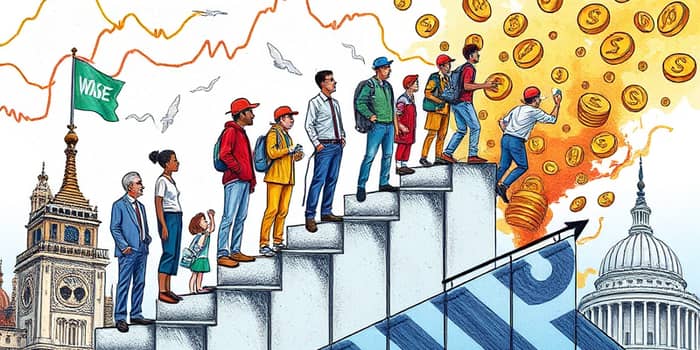
In recent years, millions of workers around the world have witnessed their paychecks struggle to keep pace with soaring prices. The tension between wage increases and rising living costs has reshaped household budgets, corporate strategies, and public policy debates. Yet, amidst these challenges, fresh solutions and collective actions offer hope for a more equitable future.
Wage growth may sound positive at first, but when prices climb faster, workers face an invisible erosion of everyday life. Economists measure this disparity by comparing nominal wages (the number on the paycheck) to inflation, yielding the figure known as real wage growth. When inflation outpaces pay increases, purchasing power contracts.
Between 2021 and 2023, the world saw its sharpest inflation surge in decades. Supply chain disruptions, energy shocks, and post-pandemic demand fueled price spikes. Despite employers raising wages to attract talent, most advanced economies fell behind, leaving workers to stretch every dollar further.
Not all countries experienced the same outcome. A closer look at G7 data from 2019 to 2023 reveals divergent paths:
The U.S. and Canada stand out as the only major economies where wage growth outpaced inflation overall. In Europe and Japan, real incomes have yet to catch up to their pre-pandemic peaks.
The numbers tell one side of the story, but everyday households feel this squeeze in profound ways. Families delaying home purchases, students taking on extra loans, and seniors cutting back on essentials illustrate the real stakes. The erosion of family savings and rising stress levels underscore a clarion call for change in economic priorities.
Within economies, some industries managed better gains than others. U.S. leisure and hospitality workers saw wages rise faster, reflecting labor shortages during the recovery. In contrast, education and construction lagged behind.
Meanwhile, minimum wage policies remained stagnant at the federal level in the U.S. since 2009, deepening the divide between productivity gains and real earnings. States like California lead with $15.50 per hour, whereas others linger near federal floors, sometimes as low as $2 per hour for tipped workers.
Confronting the wage-inflation gap requires a two-pronged approach: robust public policy and proactive individual action. Governments, businesses, and workers each have roles to play in forging a more sustainable trajectory.
At the policy level, experts advocate for:
Individuals and organizations can take practical steps to protect and grow income:
By aligning expectations and incentives, these measures aim to foster inclusive economic recovery initiatives and rebuild public trust through transparency.
As 2025 unfolds, early signs of recovery in real wages offer cautious optimism. The U.S. has seen wage growth outpace inflation since late 2023, and Canada follows closely. Yet, the path to restoring lost ground in Europe and Japan remains steep.
Ultimately, the battle against inflation and wage stagnation hinges on solidarity and innovation. From businessmen crafting fair compensation strategies to policymakers drafting dynamic wage laws, each action ripples outward, touching families and communities. Rising costs need not spell defeat if societies choose to invest in people and drive collective prosperity.
Let this article serve as a clarion call for change—to reimagine labor markets that champion dignity, reward effort fairly, and ensure every worker’s paycheck reflects both their contribution and the cost of living. The journey demands persistence, but the destination—a world where wages climb alongside prices—is within reach.
References













